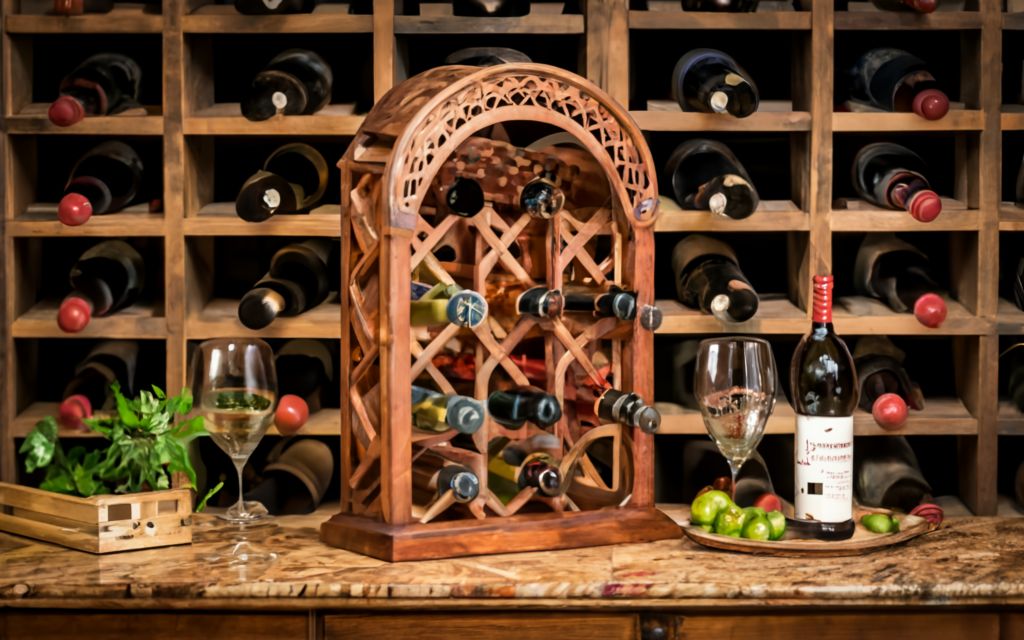Pour & Polish: The Ultimate Guide to Crafting and Refining Wooden Wine Racks
Woodworking isn’t just about crafting; it’s a form of artistry that empowers individuals to unleash their creativity and convert raw materials into visually appealing and functional pieces. Among the myriad of woodworking projects, carving and refining wooden wine racks emerge as a captivating and fulfilling pursuit for your cabinets. This comprehensive guide aims to walk you through the intricate steps of creating exquisite hand-carved wine racks and applying the ideal finish to enhance their allure and durability.
Understanding the Art of Carving Wooden Wine Racks
Before delving into the intricacies of carving and refining wooden wine racks, it’s crucial to grasp the depth of artistry inherent in this craft. The wood carving represents a time-honoured tradition, a centuries-old technique encompassing the shaping and sculpting of wood to fashion intricate designs and patterns. From the simplicity of whittling to the complexity of relief carving, wood carving methods offer an extensive array of avenues for artistic expression and ingenuity.
When creating wooden wine racks, carving bestows a personalized touch that transcends functionality, elevating each piece from mere furniture to a veritable masterpiece. Every curve, groove, and intricate detail etched into the wood represents the artisan’s skill and meticulous attention, rendering each wine rack a unique and cherished article.

A Step-by-Step Guide to Crafting Wooden Wine Racks
Embarking on the journey of crafting hand-carved wooden wine racks demands patience, precision, and an unwavering commitment to detail. Here’s a detailed guide to aid you in manifesting your creative vision:
1. Preparing the Wood for Carving
The initial step in the crafting process involves selecting the most suitable wood for your project. Opt for robust hardwoods like oak, maple, cherry, or walnut, renowned for their durability and aesthetic appeal. Following your selection, measure and carve the wood into the desired dimensions for your wine rack.
Subsequently, use sandpaper or a wood planer to meticulously smooth out any rough patches on the wood’s surface. This preparatory phase ensures the creation of a pristine and uniform canvas conducive to carving, guaranteeing a finished wine rack exuding professionalism and refinement.
2. Carving and Shaping the Wine Racks
With the meticulously prepared wood, it’s time to unleash your creative prowess and begin the carving process. Whether your inclinations lean towards traditional or contemporary designs, the key lies in executing each stroke with a deliberate and steady hand, allowing the inherent beauty of the wood to guide your endeavours.
Employ an array of tools, including carving knives, chisels, and gouges, to meticulously sculpt the wood into the desired form of your wine rack. Pay meticulous attention to minutiae such as curvature, angularity, and depth, for these elements will dictate the finished creation’s overall aesthetic and tactile experience.
Experiment freely with various carving techniques and tools to attain the desired level of intricacy and texture within your wine rack. Whether you’re etching elaborate vine motifs or simple geometric patterns, let your imagination unfurl as you breathe life into your design.
3. Sanding and Finishing Techniques
Upon the completion of the carving process, the subsequent step entails the meticulous sanding of the wine rack to eradicate any rough edges and render it receptive to applying the finishing touches. Commence with coarse-grit sandpaper to eliminate imperfections, gradually transitioning to finer grits for a lustrous and refined finish.
Post-sanding, wipe down the wine rack with a damp cloth to erase any lingering traces of dust or debris. This preparatory measure is imperative to facilitate the smooth and uniform application of the finishing coats, ultimately culminating in the creation of a final product exuding sophistication and finesse.
Selecting the Ideal Finish for Wooden Wine Racks
Selecting an appropriate finish is pivotal in augmenting your hand-carved wine rack’s visual allure and longevity. Several options abound, each endowed with its own distinct merits:
- Varnish: This option furnishes a resilient and lustrous finish that accentuates the wood’s innate beauty. It is a formidable barrier against scratches, spills, and ultraviolet radiation, rendering it ideal for wine racks subject to exposure to light and moisture.
- Lacquer: Renowned for its rapid drying time, lacquer yields a robust and enduring finish resistant to discoloration and fading over time. Available in an array of sheens ranging from matte to high gloss, lacquer allows you to tailor the appearance of your wine rack to harmonize with your personal aesthetic preferences.
- Wood Stain: Penetrating deep into the wood’s fibres, wood stain augments its colour and grain pattern while furnishing a protective shield against moisture and abrasion. With an extensive spectrum of hues and finishes, achieving the perfect aesthetic for your wine rack becomes a seamless endeavour.
- Oil Finish: Tung oil or linseed oil-based finishes permeate the wood, imbuing it with nourishment and fortification from within. These finishes offer a natural, matte appearance that accentuates the wood’s innate beauty without imparting a glossy sheen.
When deliberating upon the choice of finish for your wine rack, factors such as wood type, desired level of protection, and aesthetic preferences should be taken into meticulous consideration.
Conclusion
The craft of carving and finishing wooden wine racks epitomizes a gratifying and enriching pursuit, affording artisans a platform to showcase their ingenuity and finesse. By adhering to the meticulous guidelines delineated herein and exercising discernment in the selection of materials and finishes, you can fashion exquisite wine racks that will stand as veritable testaments to your creativity and craftsmanship. Hence, seize your tools, unfurl the tapestry of your imagination, and embark upon your woodworking odyssey today!
FAQs
- Can beginners attempt to carve wooden wine racks?
- Undoubtedly! With the appropriate tools and guidance, beginners can embark on the journey of carving and refining wooden wine racks with success. Initiate your journey with simpler designs, gradually advancing towards more intricate projects as you hone your skills and confidence.
- Which wood varieties are optimal for carving wine racks?
- Robust hardwoods such as oak, maple, cherry, and walnut reign supreme as the preferred choices for carving wine racks owing to their resilience and aesthetic appeal. These woods lend themselves admirably to carving and bestow upon the finished product a captivating natural finish that seamlessly complements any decor scheme.
- Which finish provides the utmost protection for wooden wine racks?
- The choice of finish bestowing the most comprehensive protection upon wooden wine racks hinges upon many factors including wood type, desired aesthetic, and protection requirements. Varnish, lacquer, wood stain, and oil finishes each offer distinct advantages, catering to diverse preferences and necessities.
- How should one maintain a wooden wine rack?
- Maintaining a wooden wine rack requires periodic dusting with a soft cloth or brush to dislodge any accumulated dirt or debris. Furthermore, exercise caution to avoid the direct placement of hot or moist objects upon the surface of the wine rack while periodically reapplying a wood finish or sealer to safeguard its integrity and visual allure.
- Is it feasible to customize wooden wine racks to suit specific spatial constraints?
- Indeed, wooden wine racks lend amicably to customization, accommodating specific spatial requirements and design proclivities with consummate ease. Whether you necessitate a diminutive countertop rack or an expansive floor-standing unit, bespoke woodworking empowers you to fashion wine storage solutions tailored precisely to your unique specifications.




